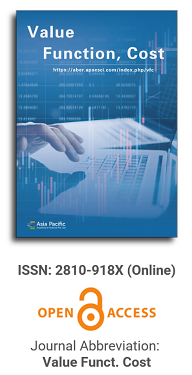
Asia Pacific Academy of Science Pte. Ltd. (APACSCI) specializes in international journal publishing. APACSCI adopts the open access publishing model and provides an important communication bridge for academic groups whose interest fields include engineering, technology, medicine, computer, mathematics, agriculture and forestry, and environment.
Research on the Coordinated Relationship between China's Provincial Environment and Economy
Vol 3, Issue 1, 2023
Download PDF
Abstract
The aim of the paper is to study the coordinated relationship between environment and economy among provinces in China. The environmental total factor productivity of 30 provinces and cities in China from 2003 to 2017 are measured using sequential ML methods, and the influencing factors of environmental total factor productivity are analyzed in a panel. It is found that: environmental total factor productivity has no obvious regional distribution characteristics, and is highly consistent with the change pattern of environmental technological progress rate, with oscillating upward characteristics; foreign capital utilization, capital increase per capita, and long-term education and science investment all have positive effects on environmental total factor productivity.
Keywords
References
- Charnes A, Cooper W W, Rhodes E. Measuring the efficiency of decision making units [J. European Journal of Operations Research, 1978, 2(6):429-444.
- Banker R D, Charnes A, Cooper w w. Some models for estimating technical and scale inefficiencies data envelopment analysis[J). Management Science, 1984,30(9):1078-1092.
- Tone K. A Slacks -Based Measure of Efficiency in Data Envelopment Analysis[J]. European Journal of Operational Research, 2001, 130(3):498-509.
- Tone K. Dealing with Undesirable Outputs in DEA: A Slacks-Based Measure Approach[R]. Toronto: North American Productivity Workshop, 2004
- Liang Yao. Research on the Impact of Digitalization Development Level on Industrial Structure Upgrading in Shaanxi Province [J]. Modern Business Industry, 2021, 42(17):12-13.
- Cooper W W, Park K S, Pastor J T. RAM: A range adjusted measure of inefficiency for use with additive models, and relations to other models and measures in DEA[J]. Journal of productivity analysis,1999,11(1):5-42.
- Chung Y H, Fare R, Grosskopf S. Productivity and Undesirable Outputs: A Directional Distance Function Approach[J]. Journal of Environmental Management, 1997, 51(3): 229-240.
- Donghyun O, Almas H. A sequential Malmquist-Luenberger productivity index: Environmentally sensitive productivity growth considering the progressive nature of technology[J]. Energy Economics, 2010,32(6):1345-1355.
- Battese G E, Prasada Rao D S,O’ Donnell C J. A metafrontier production function for estimation of technical efficiencies and technology gaps for firms operating under different technologies[J]. Journal of Productivity Analysis, 2004, 21(1):91-103.
- Tu Zhengge. The harmonization of environment, resources and industrial growth[J]. Economic Research, 2008(02):93-105.
- Nie Yuli, Wen Huwei. Empirical study on green economy efficiency in Chinese cities above prefecture level[J]. China Population·Resources and Environment, 2015, 25(S1):409-413.
- Wang Bing, Wu Yanrui, Yan Pengfei. Regional Environmental Efficiency and Environmental Total Factor Productivity Growth in China[J]. Economic Research, 2010, 45(05):95-109.
- Zhu, Wentao, Lv, Chengrui, Gu Naihua. Study on the impact of OFDI, reverse technology spillover on green total factor productivity[J]. China Population·Resources and Environment, 2019, 29(9):63-73.
- Chen S, Golley J. “Green”productivity growth in China’s industrial economy[J]. ENERGY ECONOMICS, 2014(44):89-98.
- Qian Zhengming, Liu Xiaochen. Analysis of Regional Differences and Influencing Factors of Green Economy Efficiency in China[J]. China Population·Resources and Environment, 2013, 23(07):104-109.
- Qiu Shilei, Wang Zilong, Liu Shuai, et al. Research on the heterogeneous effect of environmental regulation on environmental performance under non-expected output constraints[J]. China Population·Resources and Environment, 2018, 28 (12):40-51.
Supporting Agencies
Copyright (c) 2024 GAO Tong, Zhu Hai long

This work is licensed under a Creative Commons Attribution-NonCommercial 4.0 International License.

This site is licensed under a Creative Commons Attribution 4.0 International License (CC BY 4.0).
Zhibiao Gao
Nankai University, China

